new posts in all blogs
Viewing: Blog Posts Tagged with: 2015 nonfiction picture books, Most Recent at Top [Help]
Results 1 - 5 of 5
How to use this Page
You are viewing the most recent posts tagged with the words: 2015 nonfiction picture books in the JacketFlap blog reader. What is a tag? Think of a tag as a keyword or category label. Tags can both help you find posts on JacketFlap.com as well as provide an easy way for you to "remember" and classify posts for later recall. Try adding a tag yourself by clicking "Add a tag" below a post's header. Scroll down through the list of Recent Posts in the left column and click on a post title that sounds interesting. You can view all posts from a specific blog by clicking the Blog name in the right column, or you can click a 'More Posts from this Blog' link in any individual post.

By:
Betsy Bird,
on 11/19/2015
Blog:
A Fuse #8 Production
(
Login to Add to MyJacketFlap)
JacketFlap tags:
Reviews,
nonfiction,
nonfiction picture books,
Claire Saxby,
Best Books,
Candlewick,
Graham Byrne,
Best Books of 2015,
Reviews 2015,
2015 reviews,
2015 nonfiction,
2015 nonfiction picture books,
Add a tag
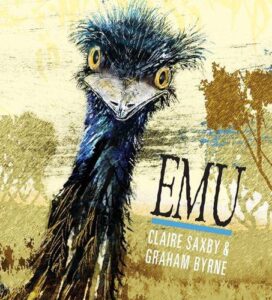 Emu
Emu
By Claire Saxby
Illustrated by Graham Byrne
Candlewick Press
$16.99
ISBN: 978-0-7636-7479-3
Ages 4-7
On shelves now.
Alas for poor emu. Forever relegated to be consider a second rate ostrich, it encompasses all of the awkwardness and none of the stereotypes. Does anyone ever talk about burying your head in the sand like an emu? They do not. Are schoolchildren routinely called upon to ooh and aah at the size of an emu’s egg? They aren’t. And when you watch Swiss Family Robinson, do you ever find yourself wishing that the kids would try to saddle an emu for the big race? Not even once. Emus are the second largest living bird in terms of height, coming right after the ostrich, and you might be fooled into believing that they are the less interesting of the two. There, you are wrong. Wrongdy wrongdy wrong wrong wrong. I do not wish to start a war of words with the prominent ostrich societies of the world, but after reading Emu by Claire Saxby (illustrated by Graham Byrne) I’m a bit of what you might consider an emu convert. Chock full of interesting information and facts about what a typical emu might experience in its day-to-day life, the book is full of thrills, chills, and a species that gives stay-at-home dads everywhere a true animal mascot.
Meet the emu. Do not be offended if he fails to rise when you approach. At the moment he is safeguarding a precious clutch of eggs from elements and predators. While many of us consider the job of hatching eggs to be something that falls to the female of the species, emus are different. Once they’ve laid their eggs, female emus just take off, and it is the male emu that hatches and rears them. In this particular example, the male emu has a brood of seven or so chicks but though they’re pretty big (ten times bigger than a domestic chicken hatchling) they need their dad for food, shelter, and protection. The chicks find their own food right from the start and within three to four months they’ve already lost their first feathers. They zigzag to escape predators, live with their fathers for about a year, and have a kick like you would not believe. Backmatter of the book provides more information about emus, as well as an index.
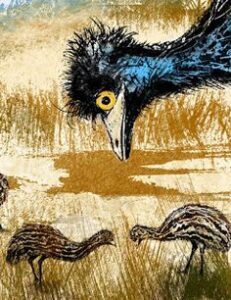 This is not what you might call Saxby and Byrne’s first rodeo show. The Aussie duo previously had paired together on the book Big Red Kangaroo, a book that did just fine for itself. Following a kangaroo called “Red”, the ostensibly nonfiction title was best described by PW as, “An understated but visually arresting portrait of a species.” For my part I had no real objections to the book, but neither did I have anything for it. Kangaroo books are not rare in my children’s rooms, though the book was different in that it was written for a younger reading level. That same reading level is the focus of Emu and here I feel that Saxby and Byrne have started to refine their technique. One of the problems I had with Red was this naming of the titular kangaroo. It felt false in a way. Like the author didn’t trust the readers enough to show them a typical day in the life of an animal without having to personalize it with faux monikers. Byrne’s art too felt flatter to me in that book than it does here. This may have more to do with the subject matter than anything else, though. Emu faces, after all, are inherently more amusing and interesting than kangaroos
This is not what you might call Saxby and Byrne’s first rodeo show. The Aussie duo previously had paired together on the book Big Red Kangaroo, a book that did just fine for itself. Following a kangaroo called “Red”, the ostensibly nonfiction title was best described by PW as, “An understated but visually arresting portrait of a species.” For my part I had no real objections to the book, but neither did I have anything for it. Kangaroo books are not rare in my children’s rooms, though the book was different in that it was written for a younger reading level. That same reading level is the focus of Emu and here I feel that Saxby and Byrne have started to refine their technique. One of the problems I had with Red was this naming of the titular kangaroo. It felt false in a way. Like the author didn’t trust the readers enough to show them a typical day in the life of an animal without having to personalize it with faux monikers. Byrne’s art too felt flatter to me in that book than it does here. This may have more to do with the subject matter than anything else, though. Emu faces, after all, are inherently more amusing and interesting than kangaroos
In terms of the text, Saxby utilizes a technique that’s proven very popular with teachers as of late. When kids in classrooms are given open reading time there can sometimes be a real range in reading levels. With this in mind, sometimes nonfiction picture books about the natural world will contain two types of text. There will be the more enticing narrative, ideal for reading aloud to a group or one-on-one. Then, for those budding naturalists, there will be a complementary second section that contains the facts. On the first two pages of Emu, for example, one side introduces the open forest with its “honey-pale sunshine” and the emu’s job while the second block of text, written in a small font that brings to mind an expert’s crisp clean handwriting, gives the statistics about emu (whether or not they can fly, their weight, height, etc.). In the back of the book under the Index there’s actually a little note about these sections. It says, “Don’t forget to look at both kinds of words”, and then writes the words “this kind and this kind” in the two different fonts.
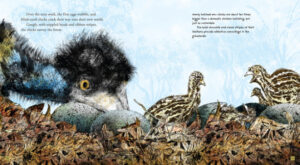 Artist Graham Byrne’s bio says that he’s an electrical engineer, builder, and artist. This is his second picture book and the art is rendered digitally. What it looks like is scratchboard art, with maybe an ink overlay as well. I enjoyed the sense of place and the landscapes but what really made me happy was how Byrne draws an emu. There’s something about that bright yellow eye in the otherwise impassive face that gets me. I say impassive, but there are times when one wonders if Byrne is fighting an instinct to give his emu some expression. There’s a scene of the emu nosing his eggs, his beak appears to be curling up in just the slightest of smiles. Later an eagle threatens his brood and there’s almost a hint of a frown as he runs over to the rescue. It’s not enough to take you out of the story, but such images bear watching.
Artist Graham Byrne’s bio says that he’s an electrical engineer, builder, and artist. This is his second picture book and the art is rendered digitally. What it looks like is scratchboard art, with maybe an ink overlay as well. I enjoyed the sense of place and the landscapes but what really made me happy was how Byrne draws an emu. There’s something about that bright yellow eye in the otherwise impassive face that gets me. I say impassive, but there are times when one wonders if Byrne is fighting an instinct to give his emu some expression. There’s a scene of the emu nosing his eggs, his beak appears to be curling up in just the slightest of smiles. Later an eagle threatens his brood and there’s almost a hint of a frown as he runs over to the rescue. It’s not enough to take you out of the story, but such images bear watching.
In comparing the emu to the ostrich I may have omitted certain pertinent details. After all, the emu doesn’t have it quite so bad. It appears on the Australian coat of arms, as well as on their money. There was an Emu War of 1932 where the emus actually won the day. Heck, it’s even not too difficult to find emus on farms in the United States. Still, culturally they’ve a far ways to go if ever they are to catch up with their ostrichy brethren fame-wise. Books like this one will help. I think there must be plenty of teachers out there a little tired of using Eric Carle’s Mister Seahorse as their de facto responsible-dads-in-the-wild motif. Now kids outside of Australia will get a glimpse of this wild, wacky, wonderful and weird creature. Consider it worth meeting.
On shelves now.
Source: Final copy sent from publisher for review.
Like This? Then Try:


By:
Betsy Bird,
on 9/9/2015
Blog:
A Fuse #8 Production
(
Login to Add to MyJacketFlap)
JacketFlap tags:
2015 Sibert Award contender,
Best Books of 2015,
Reviews 2015,
2015 reviews,
2015 nonfiction,
2015 nonfiction picture books,
2015 biography,
Reviews,
nonfiction,
Don Tate,
Chris Barton,
nonfiction picture books,
biographies,
Best Books,
Eerdmans Books for Young Readers,
picture book biographies,
Add a tag
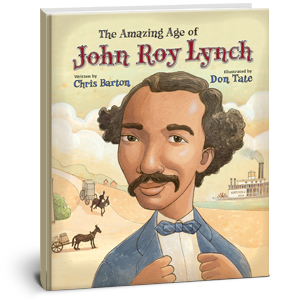 The Amazing Age of John Roy Lynch
The Amazing Age of John Roy Lynch
By Chris Barton
Illustrated by Don Tate
Eerdmans Books for Young Readers
$17.00
ISBN: 978-0-8028-5379-0
Ages 4-8
On shelves now
“It’s the story of a guy who in ten years went from teenage field slave to U.S. Congressman.” Come again? That’s the pitch author Chris Barton pulled out when he wanted to describe this story to others. You know, children’s book biographies can be very easy as long as you cover the same fifteen to twenty people over and over again. And you could forgive a child for never imagining that there were remarkable people out there beyond Einstein, Tubman, Jefferson, and Sacajawea. People with stories that aren’t just unknown to kids but to whole swaths of adults as well. So I always get kind of excited when I see someone new out there. And I get extra especially excited when the author involved is Chris Barton. Here’s a guy who performed original research to write a picture book biography of the guys who invented Day-Glo colors (The Day-Glo Brothers) so you know you’re in safe hands. The inclusion of illustrator Don Tate was not something I would have thought up myself, but by gum it turns out that he’s the best possible artist for this story! Tackling what turns out to be a near impossible task (explaining Reconstruction to kids without plunging them into the depths of despair), this keen duo present a book that reads so well you’re left wondering not just how they managed to pull it off, but if anyone else can learn something from their technique.
From birth until the age of sixteen John Roy Lynch was a slave. The son of an overseer who died before he could free his family, John Roy began life as a house slave but was sent to the fields when his high-strung mistress made him the brunt of her wrath. Not long after, The Civil War broke out and John Roy bought himself a ride to Natchez and got a job. He started out as a waiter than moved on to pantryman, photographer, and in time orator and even Justice of the Peace. Then, at twenty-four years of age, John Roy Lynch was elected to the Mississippi House of Representatives where he served as Speaker of the House. The year was 1869, and these changes did not pass without incident. Soon an angry white South took its fury out on its African American population and the strides that had been made were rescinded violently. John Roy Lynch would serve out two terms before leaving office. He lived to a ripe old age, dying at last in 1939. A Historical Note, Timeline, Author’s Note, Illustrator’s Note, Bibliography of books “For Further Reading”, and map of John’s journey and the Reconstructed United States circa 1870 appear at the end.
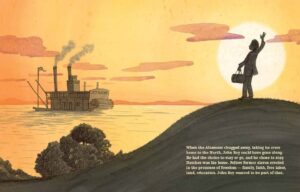 How do you write a book for children about a time when things were starting to look good and then plummeted into bad for a very very long time? I think kids have this perception (oh heck, a bunch of adults too) that we live in the best of all possible worlds. For example, there’s a children’s book series called Infinity Ring where the basic premise is that bad guys have gone and changed history and now it’s up to our heroes to put everything back because, obviously, this world we live in right now is the best. Simple, right? Their first adventure is to make sure Columbus “discovers” America so . . . yup. Too often books for kids reinforce the belief that everything that has happened has to have happened that way. So when we consider how few books really discuss Reconstruction, it’s not exactly surprising. Children’s books are distinguished, in part, by their capacity to inspire hope. What is there about Reconstruction to cause hope at all? And how do you teach that to kids?
How do you write a book for children about a time when things were starting to look good and then plummeted into bad for a very very long time? I think kids have this perception (oh heck, a bunch of adults too) that we live in the best of all possible worlds. For example, there’s a children’s book series called Infinity Ring where the basic premise is that bad guys have gone and changed history and now it’s up to our heroes to put everything back because, obviously, this world we live in right now is the best. Simple, right? Their first adventure is to make sure Columbus “discovers” America so . . . yup. Too often books for kids reinforce the belief that everything that has happened has to have happened that way. So when we consider how few books really discuss Reconstruction, it’s not exactly surprising. Children’s books are distinguished, in part, by their capacity to inspire hope. What is there about Reconstruction to cause hope at all? And how do you teach that to kids?
Barton’s solution is clever because rather than write a book about Reconstruction specifically, he’s found a historical figure that guides the child reader effortlessly through the time period. Lynch’s life is perfect for every step of this process. From slavery to a freedom that felt like slavery. Then slow independence, an education, public speaking, new responsibilities, political success, two Congressional terms, and then an entirely different life after that (serving in the Spanish-American War as a major, moving to Chicago, dying). Barton shows his rise and then follows his election with a two-page spread of KKK mayhem, explaining that the strides made were taken back “In a way, the Civil War wasn’t really over. The battling had not stopped.” And after quoting a speech where Lynch proclaims that America will never be free until “every man, woman, and child can feel and know that his, her, and their rights are fully protected by the strong arm of a generous and grateful Republic,” Barton follows it up with, “If John Roy Lynch had lived a hundred years (and he nearly did), he would not have seen that come to pass.” Barton guides young readers to the brink of the good and then explains the bad, giving context to just how long the worst of it continued. He also leaves it up to them to determine if Lynch’s dream has come to fruition or not (classroom debate time!).
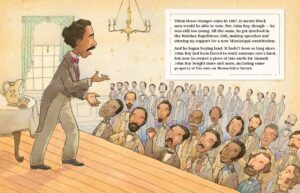 And he plays fair. These days I read nonfiction picture books with my teeth clenched. Why? Because I’ve started holding them to high standards (doggone it). And there are so many moments in this book that could have been done incorrectly. Heck, the first image you see when you open it up is of John Roy Lynch’s family, his white overseer father holding his black wife tenderly as their kids stand by. I saw it and immediately wondered how we could believe that Lynch’s parents ever cared for one another. Yet a turn of the page and Barton not only puts Patrick Lynch’s profession into context (“while he may have loved these slaves, he most likely took the whip to others”) but provides information on how he attempted to buy his wife and children. Later there is some dialogue in the book, as when Lynch’s owner at one point joshes with him at the table and John Roy makes the mistake of offering an honest answer. Yet the dialogue is clearly taken from a text somewhere, not made up to fit the context of the book. I loathe faux dialogue, mostly because it’s entirely unnecessary. Barton shows clearly that one need never rely upon it to make a book exemplary.
And he plays fair. These days I read nonfiction picture books with my teeth clenched. Why? Because I’ve started holding them to high standards (doggone it). And there are so many moments in this book that could have been done incorrectly. Heck, the first image you see when you open it up is of John Roy Lynch’s family, his white overseer father holding his black wife tenderly as their kids stand by. I saw it and immediately wondered how we could believe that Lynch’s parents ever cared for one another. Yet a turn of the page and Barton not only puts Patrick Lynch’s profession into context (“while he may have loved these slaves, he most likely took the whip to others”) but provides information on how he attempted to buy his wife and children. Later there is some dialogue in the book, as when Lynch’s owner at one point joshes with him at the table and John Roy makes the mistake of offering an honest answer. Yet the dialogue is clearly taken from a text somewhere, not made up to fit the context of the book. I loathe faux dialogue, mostly because it’s entirely unnecessary. Barton shows clearly that one need never rely upon it to make a book exemplary.
Finally, you just have to stand in awe of Barton’s storytelling. Not making up dialogue is one thing. Drawing a natural link between a life and the world in which that life lived is another entirely. Take that moment when John Roy answers his master honestly. He’s banished to hard labor on a plantation after his master’s wife gets angry. Then Barton writes, “She was not alone in rage and spite and hurt and lashing out. The leaders of the South reacted the same way to the election of a president – Abraham Lincoln – who was opposed to slavery.” See how he did that? He managed to bring the greater context of the times in line with John Roy’s personal story. Many is the clunky picture book biography that shoehorns in the era or, worse, fails to mention it at all. I much preferred Barton’s methods. There’s an elegance to them.
I’ve been aware of Don Tate for a number of years. No slouch, the guy’s illustrated numerous children’s books, and even wrote (but didn’t illustrate) one that earned him an Ezra Jack Keats New Writer Honor Award (It Jes’ Happened: When Bill Traylor Started to Draw). His is a seemingly simple style. I wouldn’t exactly call it cartoony, but it is kid friendly. Clear lines. Open faces. His watercolors go for honesty and clarity and do not come across as particularly evocative. But I hadn’t ever seen the man do nonfiction, I’ll admit. And while it probably took me a page or two to understand, once I realized why Don Tate was the perfect artist for “John Roy Lynch” it all clicked into place. You see, books about slavery for kids usually follow a prescribed pattern. Some of them go for hyperrealism. Books with art by James Ransome, Eric Velasquez, Floyd Cooper, or E.B Lewis all adhere closely to this style. Then there are the books that are a little more abstract. Books with art by R. Gregory Christie, for example, traipse closely to art worthy of Jacob Lawrence. And Shane W. Evans has a style that’s significantly artistic. A more cartoony style is often considered too simplistic for the heavy subject matter or, worse, disrespectful. But what are we really talking about here? If the book is going to speak honestly about what slavery really was, the subjugation of whole generations of people, then art that hews closely to the truth is going to be too horrific for kids. You need someone who can cushion the blow, to a certain extent. It isn’t that Tate is shying away from the horrors. But when he draws it it loses some of its worst terrors. There is one two-page spread in this book that depicts angry whites whipping and lynching their black neighbors.  It’s not shown as an exact moment in time, but rather a composite of events that would have happened then. And there’s something about Tate’s style that makes it manageable. The whip has not yet fallen and the noose has not yet been placed around a neck, but the angry mobs are there and you know that the worst is imminent. Most interesting to me too is that far in the background a white woman and her two children just stand there, neither approving nor condemning the action. I think you could get a very good conversation out of kids about this family. What are they feeling? Whose side are they on? Why don’t they do something?
It’s not shown as an exact moment in time, but rather a composite of events that would have happened then. And there’s something about Tate’s style that makes it manageable. The whip has not yet fallen and the noose has not yet been placed around a neck, but the angry mobs are there and you know that the worst is imminent. Most interesting to me too is that far in the background a white woman and her two children just stand there, neither approving nor condemning the action. I think you could get a very good conversation out of kids about this family. What are they feeling? Whose side are they on? Why don’t they do something?
And Tate has adapted his style, you can see. Compare the heads and faces in this book to those in one of his earlier books like, Ron’s Big Mission by Rose Blue, in this one he modifies the heads, making them a bit smaller, in proportion with the rest of the body. I was particularly interested in how he did faces as well. If you watch Lynch’s face as a child and teen it’s significant how he keeps is features blank in the presence of white people. Not expressionless, but devoid of telltale thoughts. As a character, the first time he smiles is when he finally has a job he can be paid for. With its silhouetted moments, good design sense, tapered but not muted color palette, and attention to detail, Mr. Tate puts his all into what is by far his most sophisticated work to date.
This year rage erupted over the fact that the Confederate flag continues to fly over the South Carolina statehouse grounds. To imagine that the story Barton relates here does not have immediate applications to contemporary news is facile. As he mentions in his Author’s Note, “I think it’s a shame how little we question why the civil rights movement in this country occurred a full century following the emancipation of the slaves rather than immediately afterward.” So as an author he found an inspiring, if too little known, story of a man who did something absolutely astounding. A story that every schoolchild should know. If there’s any justice in the universe, after reading this book they will. Reconstruction done right. Nonfiction done well.
On shelves now.
Source: Final copy sent from publisher for review.
Like This? Then Try:
Professional Reviews:
Misc: For you, m’dear? An educator’s guide.
Videos: A book trailer and everything!


By:
Betsy Bird,
on 7/1/2015
Blog:
A Fuse #8 Production
(
Login to Add to MyJacketFlap)
JacketFlap tags:
Reviews,
nonfiction picture books,
Scholastic,
Best Books,
Arthur A. Levine,
Sean Qualls,
Selina Alko,
Best Books of 2015,
Reviews 2015,
2015 reviews,
2015 nonfiction picture books,
Add a tag
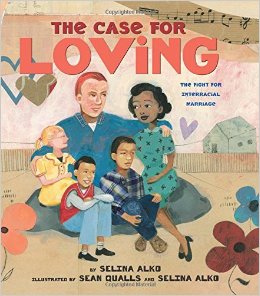 The Case for Loving: The Fight for Interracial Marriage
The Case for Loving: The Fight for Interracial Marriage
By Selina Alko
Illustrated by Sean Qualls
Arthur A. Levine Books (an imprint of Scholastic)
$18.99
ISBN: 978-0545478533
Ages 4-7
On shelves now.
When the Supreme Court ruled on June 26, 2015 that same-sex couples could marry in all fifty states, I found myself, like many parents of young children, in the position of trying to explain the ramifications to my offspring. Newly turned four, my daughter needed a bit of context. After all, as far as she was concerned gay people had always had the right to marry so what exactly was the big deal here? In times of change, my back up tends to be children’s books that discuss similar, but not identical, situations. And what book do I own that covers a court case involving the legality of people marrying? Why, none other than The Case for Loving: The Fight for Interracial Marriage by creative couple Selina Alko and Sean Qualls. It’s almost too perfect that the book has come out the same year as this momentous court decision. Discussing the legal process, as well as the prejudices of the time, the book offers to parents like myself not just a window to the past, but a way of discussing present and future court cases that involve the personal lives of everyday people. Really, when you take all that into consideration, the fact that the book is also an amazing testament to the power of love itself . . . well, that’s just the icing on the cake.
In 1958 Richard Loving, a white man, fell in love with Mildred Jeter, a black/Native American woman. Residents of Virginia, they could not marry in their home state so they did so in Washington D.C. instead. Then they turned right around and went home to Virginia. Not long after they were interrupted in the night by a police invasion. They were charged with “unlawful cohabitation” and were told in no uncertain terms that if they were going to continue living together then they needed to leave Virginia. They did, but they also hired lawyers to plead their case. By 1967 the Lovings made it all the way to The Supreme Court where their lawyers read a prepared statement from Richard. It said, “Tell the court I love my wife, and it is just unfair that I can’t live with her in Virginia.” In a unanimous ruling, the laws restricting such marriages were struck down. The couple returned to Virginia, found a new house, and lived “happily (and legally) ever after.” An Author’s Note about her marriage to Sean Qualls (she is white and he is black) as well as a note about the art, Sources, and Suggestions for Further Reading appear at the end of the book.
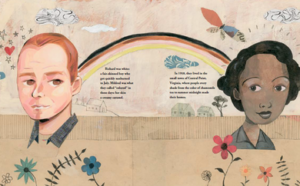 “How do you sue someone?” Here’s a challenge. Explain the concept of suing the government to a four-year-old brain. To do so, you may have to explain a lot of connected concepts along the way. What is a lawyer? And a court? And, for that matter, why are the laws (and cops) sometimes wrong? So when I pick up a book like The Case for Loving as a parent, I’m desperately hoping on some level that the authors have figured out how to break down these complex questions into something small children can understand and possibly even accept. In the case of this book, the legal process is explained as simply as possible. “They wanted to return to Virginia for good, so they hired lawyers to help fight for what was right.” And then later, “It was time to take the Loving case all the way to The Supreme Court.” Now the book doesn’t explain what The Supreme Court was necessarily, and that’s where the art comes in. Much of the heavy lifting is done by the illustrations, which show the judges sitting in a row, allowing parents like myself the chance to explain their role. Here you will not find a deep explanation of the legal process, but at least it shows a process and allows you to fill in the gaps for the young and curious.
“How do you sue someone?” Here’s a challenge. Explain the concept of suing the government to a four-year-old brain. To do so, you may have to explain a lot of connected concepts along the way. What is a lawyer? And a court? And, for that matter, why are the laws (and cops) sometimes wrong? So when I pick up a book like The Case for Loving as a parent, I’m desperately hoping on some level that the authors have figured out how to break down these complex questions into something small children can understand and possibly even accept. In the case of this book, the legal process is explained as simply as possible. “They wanted to return to Virginia for good, so they hired lawyers to help fight for what was right.” And then later, “It was time to take the Loving case all the way to The Supreme Court.” Now the book doesn’t explain what The Supreme Court was necessarily, and that’s where the art comes in. Much of the heavy lifting is done by the illustrations, which show the judges sitting in a row, allowing parents like myself the chance to explain their role. Here you will not find a deep explanation of the legal process, but at least it shows a process and allows you to fill in the gaps for the young and curious.
It was very interesting to me to see how Alko and Qualls handled the art in this book. I’ve often noticed that editors like to choose Sean as an artist when they want an illustrator that can offset some of the darker aspects of a work. For example, take Margarita Engle’s magnificently sordid Pura Belpre Medal winner The Poet Slave of Cuba. A tale of torture, gore, and hope, Qualls’ art managed to represent the darkness with a lighter touch, while never taking away from the important story at hand. In The Case for Loving he has scaled the story down a bit and given it a simpler edge. His characters are a bit broader and more cartoonlike than those in, say, Dizzy. This is due in part to Alko’s contributions. As they say in their “About the Art” section at the back of the book, Alko’s art is all about bold colors and Sean’s is about subtle layers of color and texture. Together, they alleviate the tension in different scenes. Moments that could be particularly frightening, as when the police burst into the Lovings’ bedroom to arrest them, are cast instead as simply dramatic. I noticed too that characters were much smaller in this book than they tend to be in Sean’s others. It was interesting to note the moments when that illustrators made the faces of Richard and Virginia large. The page early in the book where Richard and Mildred look at one another over the book’s gutter pairs well with the page later in the book where their faces appear on posters behind bars against the words “Unlawful Cohabitation”. But aside from those two double spreads the family is small, often seen just outside their different respective homes. It seemed to be important to Qualls and Alko to show them as a family unit as often as possible.
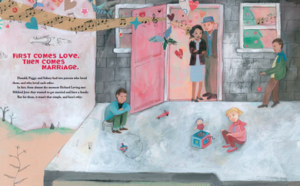 Few books are perfect, and Loving has its off-kilter moments from time to time. For example, it describes darker skin tones in terms of food. That’s not a crime, of course, but you rarely hear white skin described as “white as aged cheese” or “the color of creamy mayonnaise” so why is dark colored skin always edible? In this book Mildred is “a creamy caramel” and she lives where people ranged from “the color of chamomile tea” to darker shades. A side issue has arisen concerning Mildred’s identification as Native American and whether or not the original case made more of her African-American roots because it would build a stronger case in court. This is a far bigger issue than a picture book could hope to encompass, though I would be interested in a middle grade or young adult nonfiction book on the topic that went into the subject in a little more depth.
Few books are perfect, and Loving has its off-kilter moments from time to time. For example, it describes darker skin tones in terms of food. That’s not a crime, of course, but you rarely hear white skin described as “white as aged cheese” or “the color of creamy mayonnaise” so why is dark colored skin always edible? In this book Mildred is “a creamy caramel” and she lives where people ranged from “the color of chamomile tea” to darker shades. A side issue has arisen concerning Mildred’s identification as Native American and whether or not the original case made more of her African-American roots because it would build a stronger case in court. This is a far bigger issue than a picture book could hope to encompass, though I would be interested in a middle grade or young adult nonfiction book on the topic that went into the subject in a little more depth.
Recently I read my kid another nonfiction picture book chronicling injustice called Drum Dream Girl by the aforementioned Margarita Engle. In that book a young girl isn’t allowed to drum because of her gender. My daughter was absolutely flabbergasted by the notion. When I read her The Case for Loving she was similarly baffled. And when, someday, someone writes a book about the landmark decision made by The Supreme Court to allow gay couples to wed, so too will some future child be just as floored by what seems completely normal to them. Until then, this is certainly a book written and published at just the right time. Informative and heartfelt all at once, it works beyond the immediate need. Context is not an easy thing to come by when we discuss complex subjects with our kids. It takes a book like this to give us the words we so desperately need. Many thanks then for that.
On shelves now.
Source: Galley sent from publisher for review.
Like This? Then Try:
Misc: Don’t forget to check out this incident that occurred involving this book and W. Kamau Bell’s treatment at Berkeley’s Elmwood Café.


By:
Betsy Bird,
on 5/9/2015
Blog:
A Fuse #8 Production
(
Login to Add to MyJacketFlap)
JacketFlap tags:
Best Books of 2015,
Reviews 2015,
2015 reviews,
2015 nonfiction,
2015 nonfiction picture books,
2016 Sibert Award candidate,
Lindsay Mattick,
Reviews,
nonfiction,
nonfiction picture books,
Winnie-the-Pooh,
Sophie Blackall,
Little Brown and Company,
Add a tag
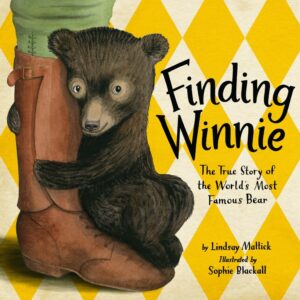 Finding Winnie: The True Story of the World’s Most Famous Bear
Finding Winnie: The True Story of the World’s Most Famous Bear
By Lindsay Mattick
Illustrated by Sophie Blackall
$18.00
ISBN: 978-0-316-32490-8
Ages 4-7
On shelves October 20th
What is it with bears and WWI? Aw, heck. Let’s expand that question a tad. What is it with adorable animals and WWI? Seems these days no matter where you turn you find a new book commemorating a noble creature’s splendor and sacrifice on the battlefields of Europe. If it’s not Midnight, A True Story of Loyalty in World War I by Mark Greenwood or Stubby the War Dog: The True Story of WWI’s Bravest Dog by Ann Bausum, it’s Voytek, the Polish munitions bear in Soldier Bear or, best known of them all, the inspiration for Winnie-the-Pooh. With the anniversary of WWI here, the children’s literary sphere has witnessed not one but two picture book biographies of Winnie, the real bear that inspired Christopher Robin Milne and, in turn, his father A.A. Milne. The first of these books was Winnie: The True Story of the Bear That Inspired Winnie-the-Pooh by Sally M. Walker. A good strong book, no bones about it. But Finding Winnie has an advantage over the Walker bio that cannot be denied. One book was researched and thought through carefully. The other? Written by one of the descendants of the veterinarian that started it all. Add in the luminous artwork of Sophie Blackall and you’ve got yourself a historical winner on your hands.
Now put yourself in Harry’s shoes. You’re suited up. You’re on a train. You’re headed to training for the Western Front where you’ll be a service vet, aiding the horses there. The last thing you should do is buy a baby bear cub at a train station, right? I suppose that was the crazy thing about Harry, though. As a vet he had the skills and the knowledge to make his plan work. And as for the bear, she was named Winnipeg (or just Winnie for short), and she instantly charmed Harry’s commanding officer and all his fellow soldiers. During training she was great for morale, and before you knew it she was off with the troop overseas. But with the threat of real combat looming, Harry had a difficult decision to make. This little bear wasn’t suited for the true horrors of war. Instead, he dropped her off at The London Zoo where she proceeded to charm adults and children alike. That was where she made the acquaintance of Christopher Robin Milne and inspired the name of the world’s most famous stuffed animal. Framed within the context of author Lindsay Mattick telling this story to her son Cole, Ms. Mattick deftly weaves a family story in with a tale some might know but few quite like this.
Right from the start I was intrigued by the book’s framing sequence. Here we have a bit of nonfiction for kids, and yet all throughout the book we’re hearing Cole interjecting his comments as his mother tells him this story. It’s a unique way of presenting what is already an interesting narrative in a particularly child-friendly manner. But why do it at all? What I kept coming back to as I read the book was how much it made the story feel like A.A. Milne’s. Anyone who has attempted to read the first Winnie-the-Pooh book to their small children will perhaps be a bit surprised by the extent to which Christopher Robin’s voice keeps popping up, adding his own color commentary to the proceedings. Cole’s voice does much the same thing, and once I realized that Mattick was playing off of Milne’s classic, other Winnie-the-Pooh callbacks caught my eye. There’s the Colonel’s surprised “Hallo” when he first meets Winnie, which struck me as a particularly Pooh-like thing to say. There are the comments between Harry’s heart and head which reminded me, anyway, of Pooh’s conversations with his stomach. They are not what I would call overt callbacks but rather like subtle little points of reference for folks who are already fans.
I was struck my Mattick’s attention to accuracy and detail too. The temptation in these sorts of books is to fill them up with fake dialogue. One might well imagine that the conversation with Cole is based on actual conversations, possibly culled together from a variety of different accounts. Since Mattick isn’t saying this-happened-like-this-on-precisely-this-date we can enjoy it for what it is. As for Harry’s tale, you only occasionally get a peek into his brain and when you do it’s in his own words, clearly taken from written accounts. Mattick does not divulge these accounts, sadly, so there’s nothing in the back of the book so useful as a Bibliography. However, that aside, the book rings true. So much so that it almost makes me doubt other accounts I’ve read.
As for the text itself, I was mildly surprised by how good the writing was. Mattick makes some choices that protect the young readers while keeping the text accurate. For example, when little Cole asks what trappers, like the one who killed Winnie’s mother, do, Lindsay’s answer is to say, “It’s what trappers don’t do. They don’t raise bears.” Hence, Harry had to buy it. She also has a nice little technique, which I alluded to earlier, where Harry’s heart and mind are at odds. The heart allows him to buy Winnie and take her overseas. The mind wins in terms of taking her to The London Zoo in the end.
I like to put myself in the place of the editor of this book. The manuscript has come in. I like it. I want to publish it. I get the thumbs up from my publisher to go ahead and then comes the part where I find an illustrator for it. I want somebody who can emote. Someone just as adept at furry baby bear cubs as they are soldiers in khaki with teeny tiny glasses. But maybe I want something more. Maybe I want an illustrator who puts in the rudimentary details, then adds their own distinctive style to the mix. I’m willing to get an artist who could potentially overshadow the narrative with visual beauty. In short, I want a Sophie Blackall.
Now I’ve heard Ms. Blackall speak on a couple occasions about the meticulous research she conducted for this book. The Canadian flag she initially mistakenly placed on a ship of war has been amended from an earlier draft (the Canadian flag wasn’t officially adopted until 1965). She researched The London Zoo for an aerial shot that includes everything from the squirrel enclosure to Winnie’s small block of concrete or stone. Blackall also includes little visual details that reward multiple readings. A scene where Harry departs on the train, surrounded by people saying goodbye, is contrasted by a later scene where he returns and far fewer people are saying hello to their loved ones. One soldier has lost a leg. Another greets his much larger son and perpetually handkerchief clutching wife. Another doesn’t appear at all. And finally, Blackall throws in beautiful two-page spreads for the sake of beauty alone. The initial endpapers show an idyllic woodland scene, presumably in Canada. Later we’ve this red sky scene of the ship proceeding across the Atlantic Ocean to Europe. For a book about WWI, that red is the closest we come (aside from the aforementioned missing leg) to an allusion to the bloody conflict happening elsewhere. It’s beautiful and frightening all at once.
In the world of children’s literature you never get a single book on the subject and then say, “There! Done! We don’t need any more!” It doesn’t matter how great a book is, there’s always room for another. And it seems to me that on the topic of Winnie the bear, friend of Christopher Robin, inspiration to a platoon, there is plenty of wiggle room. Hers is a near obscure tale that is rapidly becoming better and better known each day. I think that this pairs magnificently with Walker’s Winnie. For bear enthusiasts, Winnie enthusiasts, history lovers, and just plain old folks who like a good story. In short, for silly old bears.
On shelves October 20th.
Source: F&G sent from publisher for review.
Like This? Then Try:


By:
Betsy Bird,
on 2/11/2015
Blog:
A Fuse #8 Production
(
Login to Add to MyJacketFlap)
JacketFlap tags:
Reviews,
nonfiction picture books,
Winnie-the-Pooh,
Sally M. Walker,
Reviews 2015,
2015 reviews,
2015 nonfiction,
2015 nonfiction picture books,
Jonathan D. Voss,
Add a tag
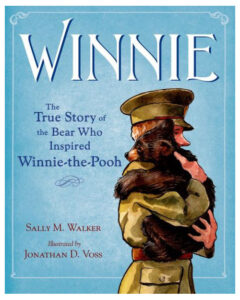 Winnie: The True Story of the Bear That Inspired Winnie-the-Pooh
Winnie: The True Story of the Bear That Inspired Winnie-the-Pooh
By Sally M. Walker
Illustrated by Jonathan D. Voss
Henry Holt (an imprint of Macmillan)
$17.99
ISBN: 978-0805097153
Ages 4-7
On shelves now
I worked in close proximity to the real Winnie-the-Pooh for five years. From 2006 to 2011 he was a daily delight. To clarify, I was working alongside the original Winnie-the-Pooh toys owned by the real Christopher Robin, son of A.A. Milne in New York Public Library’s Central Children’s Room. We had Piglet, Tigger, Kanga (no Roo), Eeyore, and Winnie himself. Though ironically I never read his books as a child, in my time as a children’s librarian working in the Children’s Center at 42nd Street I became well versed in his story. Winnie was purchased at Harrods for Christopher Robin who eventually named him “Winnie” after some bear he’d seen in a zoo. If pressed to conjure up facts about that zoo bear I might have been able to tell you that its name was Winnipeg, but that was about as far as my knowledge on the matter went. Sometimes it takes a children’s book to learn about a children’s book character. Winnie: The True Story of the Bear That Inspired Winnie-the-Pooh relates the true history of a man and his bear. Illustrated with aplomb by Jonathan D. Voss, the book’s charm is the true measure by which you can assess how well it lives up to its namesake. Accuracy and adorableness in one small, furry package.
There are many things Harry Colebourn could have purchased as his troop passed through the small train station, but what did he end up with? A baby bear. A baby black bear, if you want to be precise about it. Good natured and orphaned, Harry promptly names her “Winnie” after his company’s hometown “Winnipeg” and she becomes the darling of his troop. When WWI calls his company across the wide ocean, Winnie comes along. But killing fields are no place for a baby bear so it’s to the London Zoo that Winnie goes. Once there, Harry promises her that when the war is done he’ll take her back to Winnipeg. It’s a promise he doesn’t keep. Upon his return Harry sees that Winnie is not only happy but a star of the zoo. She’s so gentle that children everywhere come to see her. Even a boy by the name of Christopher Robin . . . Copious photographs of the real Winnie and Harry grace the front endpapers while Christopher Robin graces the back. There is an additional Author’s Note on Harry, Winnie, and black bears as well as a Bibliography of sources.
As I began reading the book I wondered if the story of Winnie would be akin to other military animal tales out there. Would Winnie aid the Allies much in the same way as Voytek in Poland or was she more of a mascot like Stubby? Neither, as it happens. Though Winnie did make it onto a boat headed for France, her keeper was smart enough to recognize that while some bears would thrive in a war zone (see: Voytek), Winnie was not one of them. Really she was just a baby and after seeing her playing and cuddling with Harry the thought of her existing in a place where bullets would fly is terrifying. This is a sweet wartime tale, perfect for reading to younger children who take things on face value and aren’t aware of what WWI really entailed.
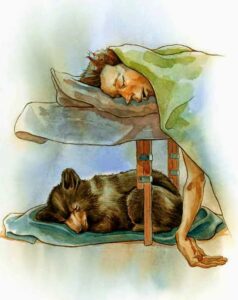 The art of Jonathan D. Voss caught me by surprise. With just a half glance at the cover I initially though the illustrator was Amy June Bates (who illustrated the somewhat similar Christian, the Hugging Lion back in 2010). An understandable mistake but once I actually went so far as to, oh I dunno LOOK at the book, I could see that Voss has a crisper line as well as a sure and steady grasp on the material. This being the first picture book that he has illustrated, he does a good job of making some really iconic images. The view on the cover of Harry hugging Winnie to his chest, as one might cuddle an infant, is downright heartwarming. Likewise the image of Winnie asleep under Harry’s cot as his long arm drapes down, his wrist bending in sleep, works. And if the four shots of Harry playing with Winnie were a YouTube video they’d get more hits than any other cute animal video to date. There is the occasional misstep, I’m afraid. A boy riding Winnie later in the book bears the slack-jawed look of a very small grown man and not a little boy. Indeed Voss appears to be most comfortable when Winnie is his focus. There’s not a single image where that bear doesn’t feel 100% authentic. One suspects the artist spent a great deal of time studying baby black bears and how they move. He also does a decent job of rendering the stuffed Pooh accurately. The arms are admittedly a bit long but the stance and nose are on target.
The art of Jonathan D. Voss caught me by surprise. With just a half glance at the cover I initially though the illustrator was Amy June Bates (who illustrated the somewhat similar Christian, the Hugging Lion back in 2010). An understandable mistake but once I actually went so far as to, oh I dunno LOOK at the book, I could see that Voss has a crisper line as well as a sure and steady grasp on the material. This being the first picture book that he has illustrated, he does a good job of making some really iconic images. The view on the cover of Harry hugging Winnie to his chest, as one might cuddle an infant, is downright heartwarming. Likewise the image of Winnie asleep under Harry’s cot as his long arm drapes down, his wrist bending in sleep, works. And if the four shots of Harry playing with Winnie were a YouTube video they’d get more hits than any other cute animal video to date. There is the occasional misstep, I’m afraid. A boy riding Winnie later in the book bears the slack-jawed look of a very small grown man and not a little boy. Indeed Voss appears to be most comfortable when Winnie is his focus. There’s not a single image where that bear doesn’t feel 100% authentic. One suspects the artist spent a great deal of time studying baby black bears and how they move. He also does a decent job of rendering the stuffed Pooh accurately. The arms are admittedly a bit long but the stance and nose are on target.
One objection I’ve heard to the story is that there isn’t enough Christopher Robin / real Winnie-the-Pooh info included in this story. I can see where this critic is coming from but I respectfully disagree. To my mind, Winnie’s story is fascinating in and of itself regardless of what famous literary character she ended up inspiring on some level. Hers is a story of tragedy turned to great good luck. Few orphaned bears in the WWI era would have found such a caring owner, let alone one that let them travel to Europe. Her life was notable at the time and makes for no less an interesting story today.
 For my part, the book gets into tricky territory when we view the quoted dialog. Now Ms. Walker is a known entity. She does this stuff for a living. Wins big nonfiction awards like the Sibert for Secrets of a Civil War Submarine and the like. So when we get to a section where Harry is quoted saying “I’ll feed her condensed milk. She can stay with me in camp. Winnipeg can be our mascot,” then we have to naturally assume that the quote comes from one of the listed sources Walker provides at the back of the book. The quotes are not sourced but since Harry’s diary is one of those aforementioned sources, there’s a strong likelihood that the quotes come from there. I’m giving the book the benefit of the doubt in this matter, since faux dialog is the bane of the modern nonfiction picture book.
For my part, the book gets into tricky territory when we view the quoted dialog. Now Ms. Walker is a known entity. She does this stuff for a living. Wins big nonfiction awards like the Sibert for Secrets of a Civil War Submarine and the like. So when we get to a section where Harry is quoted saying “I’ll feed her condensed milk. She can stay with me in camp. Winnipeg can be our mascot,” then we have to naturally assume that the quote comes from one of the listed sources Walker provides at the back of the book. The quotes are not sourced but since Harry’s diary is one of those aforementioned sources, there’s a strong likelihood that the quotes come from there. I’m giving the book the benefit of the doubt in this matter, since faux dialog is the bane of the modern nonfiction picture book.
Read this book and few will wonder that after seeing Winnie in person, Christopher Robin wanted a bear of his very own. Indeed, the vast majority of children who are read Winnie may think to themselves (or say out loud) at some point, “When do I get my own?” Sorry, kids. If it’s any consolation you can see the Winnie-the-Pooh toys in the main New York Public Library location anytime the building is open. Maybe it won’t be the same as getting to ride a sweet bear in the zoo, but it’s still a part of this story on some level. Cute, not saccharine, and pleasing to boot, this is one story-behind-the-story kids will definitely appreciate. Lovers of Pooh welcome but not required.
On shelves now.
Source: Final copy sent from publisher for review.
Like This? Then Try:
Interviews: Julie Danielson interviews Sally M. Walker about the book over at BookPage.
Misc: For more interior illustrated spreads, go to Seven Impossible Things Before Breakfast.
Video: Forgot a movie was made out of this story as well, didn’t you? You’re forgiven. It came out in 2004 and was made for TV after all. That said, it had some big name cast members. Michael Fassbender starred. Stephen Fry shows up. David Suchet. And someone put the whole thing up on YouTube so if you’ve an hour and a half to kill . . .

 Emu
Emu This is not what you might call Saxby and Byrne’s first rodeo show. The Aussie duo previously had paired together on the book Big Red Kangaroo, a book that did just fine for itself. Following a kangaroo called “Red”, the ostensibly nonfiction title was best described by PW as, “An understated but visually arresting portrait of a species.” For my part I had no real objections to the book, but neither did I have anything for it. Kangaroo books are not rare in my children’s rooms, though the book was different in that it was written for a younger reading level. That same reading level is the focus of Emu and here I feel that Saxby and Byrne have started to refine their technique. One of the problems I had with Red was this naming of the titular kangaroo. It felt false in a way. Like the author didn’t trust the readers enough to show them a typical day in the life of an animal without having to personalize it with faux monikers. Byrne’s art too felt flatter to me in that book than it does here. This may have more to do with the subject matter than anything else, though. Emu faces, after all, are inherently more amusing and interesting than kangaroos
This is not what you might call Saxby and Byrne’s first rodeo show. The Aussie duo previously had paired together on the book Big Red Kangaroo, a book that did just fine for itself. Following a kangaroo called “Red”, the ostensibly nonfiction title was best described by PW as, “An understated but visually arresting portrait of a species.” For my part I had no real objections to the book, but neither did I have anything for it. Kangaroo books are not rare in my children’s rooms, though the book was different in that it was written for a younger reading level. That same reading level is the focus of Emu and here I feel that Saxby and Byrne have started to refine their technique. One of the problems I had with Red was this naming of the titular kangaroo. It felt false in a way. Like the author didn’t trust the readers enough to show them a typical day in the life of an animal without having to personalize it with faux monikers. Byrne’s art too felt flatter to me in that book than it does here. This may have more to do with the subject matter than anything else, though. Emu faces, after all, are inherently more amusing and interesting than kangaroos Artist Graham Byrne’s bio says that he’s an electrical engineer, builder, and artist. This is his second picture book and the art is rendered digitally. What it looks like is scratchboard art, with maybe an ink overlay as well. I enjoyed the sense of place and the landscapes but what really made me happy was how Byrne draws an emu. There’s something about that bright yellow eye in the otherwise impassive face that gets me. I say impassive, but there are times when one wonders if Byrne is fighting an instinct to give his emu some expression. There’s a scene of the emu nosing his eggs, his beak appears to be curling up in just the slightest of smiles. Later an eagle threatens his brood and there’s almost a hint of a frown as he runs over to the rescue. It’s not enough to take you out of the story, but such images bear watching.
Artist Graham Byrne’s bio says that he’s an electrical engineer, builder, and artist. This is his second picture book and the art is rendered digitally. What it looks like is scratchboard art, with maybe an ink overlay as well. I enjoyed the sense of place and the landscapes but what really made me happy was how Byrne draws an emu. There’s something about that bright yellow eye in the otherwise impassive face that gets me. I say impassive, but there are times when one wonders if Byrne is fighting an instinct to give his emu some expression. There’s a scene of the emu nosing his eggs, his beak appears to be curling up in just the slightest of smiles. Later an eagle threatens his brood and there’s almost a hint of a frown as he runs over to the rescue. It’s not enough to take you out of the story, but such images bear watching.













Thank you, Betsy! Sharp-eyed readers will notice the tiny little “chicken for a dime” in the book trailer. Of all the details that Don captured, that one is my favorite.
I noticed it in the book too! It made me inordinately happy to see.
I am a fan of both Don and Chris’ work. After reading your review and watching the video, The Amazing Age of John Roy Lynch has moved to the top of my book list.
Chris Barton is rapidly becoming one of my fave nonfiction people – I want to emulate that know-how with research, and that ease of imparting it in a way that’s just… sitting on the front porch, spinning a yarn – the laden-with-facts bit of it just feels so effortless! And, WOW, Bets, that you noticed that the character had a blank face in the presence of white folk… you have sharp eyes, and Don Tate is a super-sharp artist. Thanks especially for breaking down your thoughts on the artwork. The hyperrealism – I never knew what to call it before, really – is sometimes hard for me to take, much less a child; it’s almost… ugly, in a way. I think this artwork supports a fantastic story of The Reconstruction era, and makes it enticing…
“Enticing” and “The Reconstruction era” in the same sentence is kind of surreal, isn’t it?! Kudos and well done to the author and illustrator!
[…] of books I want to read: The Amazing Age of Judge Roy Lynch by Chris Barton, reviewed at Fuse #8. The Hired Girl by Laura Amy Schlitz, reviewed by Abby the Librarian. 7 Women and the Secret of […]
[…] Elizabeth Bird, librarian extraordinaire, had a lot to say this week about The Amazing Age of John Roy Lynch on her School Library Journal blog. […]